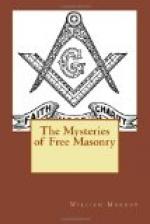Origin of this degree.—When the Knights and Princes were embodied to conquer the Holy Land, they took a cross to distinguish them, as a mark of being under its banners; they also took an oath to spend the last drop of their blood to establish the true religion of the Most High God. Peace being made, they could not fulfil their vows, and, therefore, returning home to their respective countries, they resolved to do in theory what they could not do by practice, and determined never to admit, or initiate, any into their mystic ceremonies, but those who had given proofs of friendship, zeal, and discretion. They took the name of Knights of the East and West, in memory of their homes and the place where the order began; and they have ever since strictly adhered to their ancient customs and forms. In the year 1118, the first Knights, to the number of eleven, took their vows between the hands of Garimont, Patriarch and Prince of Jerusalem, from whence the custom is derived of taking the obligation in the same position.
Lecture.—Question—Are you a Knight of the East and West? A. I am.
Q. What did you see when you were received? A. Things that were marvellous.
Q. How were you received? A. By water and the effusion of blood.
Q. Explain this to me? A. A Mason should not hesitate to spill his blood for the support of Masonry.
Q. What are the ornaments of the Grand Council? A. Superb thrones, sun, more perfumed ointment, and a basin of water.
Q. What is the figure of the draft? A. An heptagon within a circle.
Q. What is the representation of it? A. A man vested in a white robe, with a golden girdle ’round his waist—’round his right hand seven stars—his head surrounded with a glory, a long, white beard—a two-edged sword across his mouth, surrounded by seven candlesticks, with these letters: H. D. P. I. P. R.




